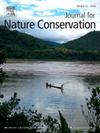Integrating hotspot analysis and priority setting for enhanced endemic Bornean palms conservation
IF 2.2
3区 环境科学与生态学
Q2 BIODIVERSITY CONSERVATION
引用次数: 0
Abstract
The Arecaceae family (palms) holds global significance for its economic and ecological roles. Borneo is known as a center of endemic plant species but faces threats from human activities, including those affecting palms. This study aims to update the distribution and conservation status of endemic Bornean palms, identify potential conservation priority areas, and conduct a gap analysis to inform conservation strategies. The methodology involved comprehensive data collection, along with spatial and statistical analysis for conservation assessment and prioritization. Despite challenges like limited data on palm distribution in Indonesia, the study provides critical insights for developing targeted conservation strategies, particularly for conservation priority areas outside protected areas. The study identified 210 endemic Bornean palms, including 16 genera and 111 local endemics, with Malaysia exhibiting the highest species richness. Preliminary global assessment categorized 147 species as threatened palms, with 51 Critically Endangered (CR), 65 Endangered (EN), and 31 Vulnerable (VU). Meanwhile, 63 species were recognized as Least Concern (LC) and Near Threatened (NT). Furthermore, we conducted a hotspot analysis to identify key areas for conservation efforts. This analysis identified 32 grids (covering 12,378.93 km2), representing 10 % of the total identified Conservation Priority Areas (CPA), and 45 grids (covering 104,257.3 km2), representing 20 %. The larger area encompassed by the 20 % CPA highlights broader landscape-level priorities, emphasizing the importance of scaling conservation efforts to address habitat connectivity and ecological resilience. These areas spanned all regions, but a higher percentage was found in Malaysia at 10 % and 20 % sensitivity levels. These findings provide important guidance for targeted conservation actions and support further discussions on the future conservation of endemic Bornean palms.
求助全文
约1分钟内获得全文
求助全文
来源期刊

Journal for Nature Conservation
环境科学-生态学
CiteScore
3.70
自引率
5.00%
发文量
151
审稿时长
7.9 weeks
期刊介绍:
The Journal for Nature Conservation addresses concepts, methods and techniques for nature conservation. This international and interdisciplinary journal encourages collaboration between scientists and practitioners, including the integration of biodiversity issues with social and economic concepts. Therefore, conceptual, technical and methodological papers, as well as reviews, research papers, and short communications are welcomed from a wide range of disciplines, including theoretical ecology, landscape ecology, restoration ecology, ecological modelling, and others, provided that there is a clear connection and immediate relevance to nature conservation.
Manuscripts without any immediate conservation context, such as inventories, distribution modelling, genetic studies, animal behaviour, plant physiology, will not be considered for this journal; though such data may be useful for conservationists and managers in the future, this is outside of the current scope of the journal.
 求助内容:
求助内容: 应助结果提醒方式:
应助结果提醒方式:


